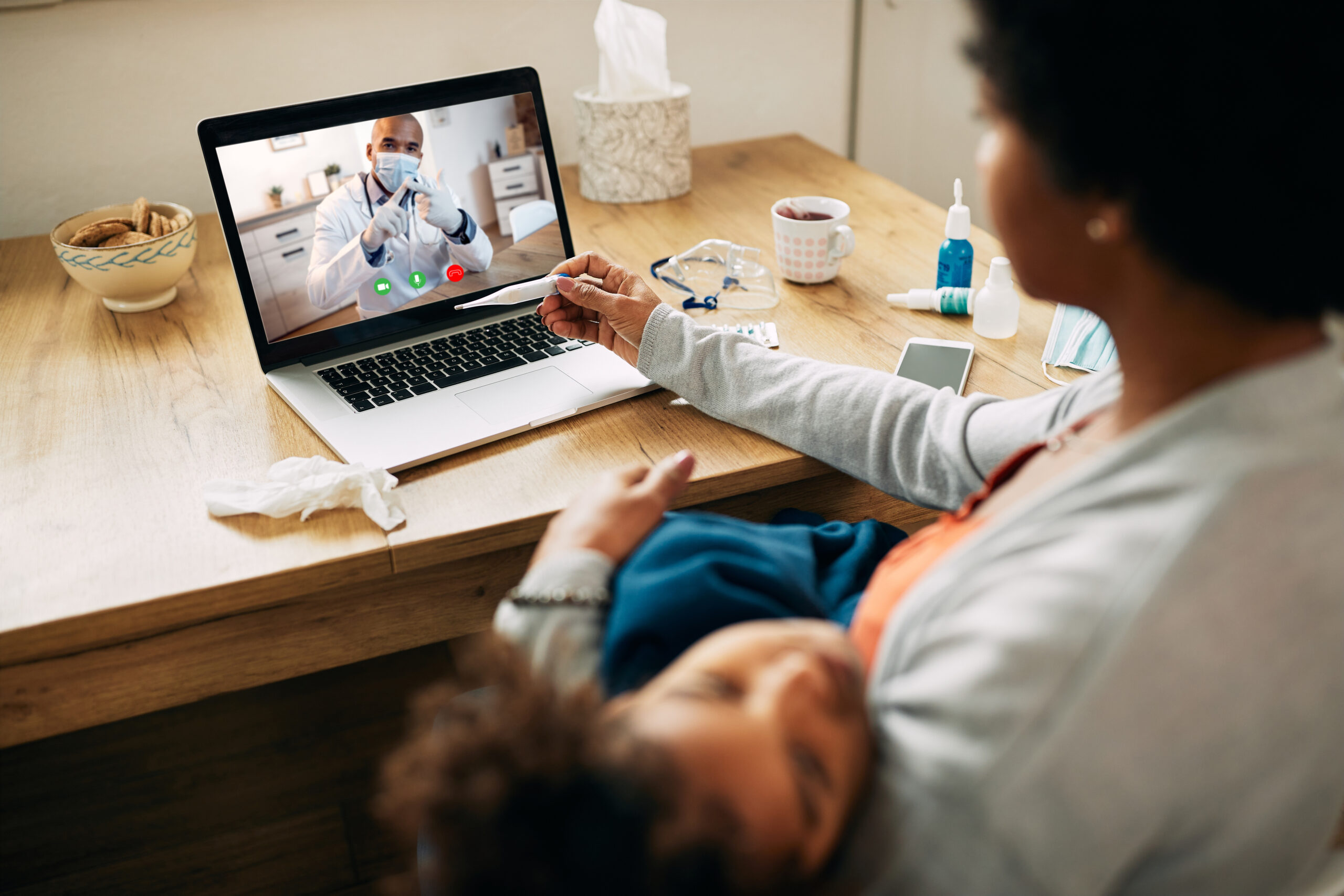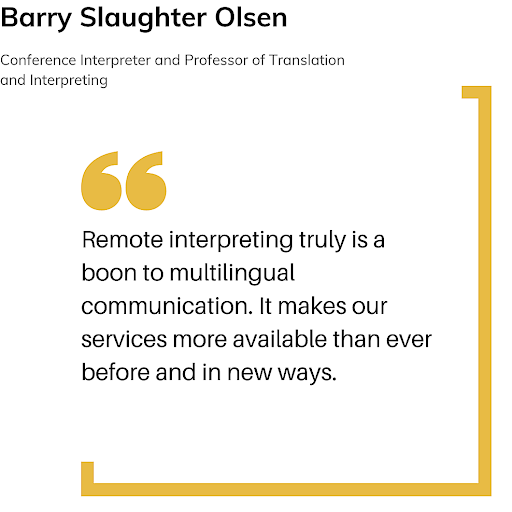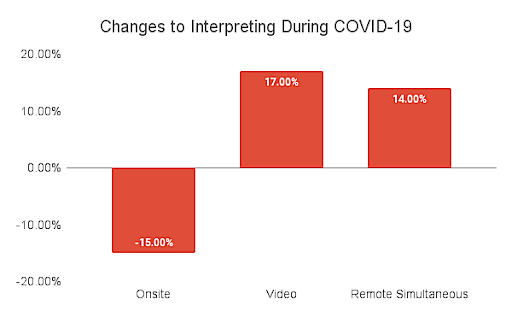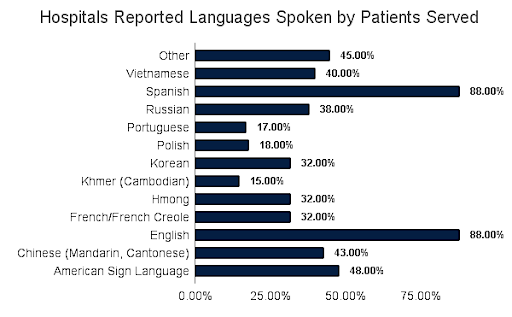Transform Communication in Healthcare with Remote Interpretation (VRI)
The United States continues to evolve as a culturally and linguistically diverse nation. In fact, there are now nearly 70 million US residents who speak a language other than English (LOTE) at home and over 25 million residents with limited-English proficiency (LEP). As such, providing language access to LEP patients has not only become an increasingly popular topic but has also become the law. One way for staff to communicate effectively with LEP patients — especially in times of public health crises — is to invest in virtual remote interpreting (VRI). As Conference Interpreter and Professor of Translation and Interpreting, Barry Slaughter Olsen puts it, “[r]emote interpreting truly is a boon to multilingual communication. It makes our services more available than ever before and in new ways.”1
Data Source: The Joint Commission
Study after study has shown that professional interpreting services improve patient outcomes, lower 30-day readmissions, and decrease the length of hospital stays all while saving a hospital’s resources and money. The latest pandemic created a heightened awareness in the medical community of the dire need for healthcare interpreting. Why? Well, in a nutshell, the LEP patient community is disproportionately affected by the virus. For starters, the limited ability of the media to disseminate public safety announcements in multiple languages inadvertently excludes the LEP population from understanding how to keep themselves and their loved ones safe. The LEP population is also more likely to work in service-related fields, further exposing them to the virus. And then there is the lack of professional, medically-qualified interpreters at the hospital level. In the past, many hospitals relied solely on bilingual staff or a patient’s family members to act as interpreters. However, not only does this approach pull these professionals away from other responsibilities, but being bilingual does not qualify a person to act as a medical interpreter. Even worse, relying on family members to act as interpreters can lead to misunderstandings and the withholding of critical information.
COVID Impact on Healthcare Interpreting Services
When social distancing mandates hit the hospital level in an effort to curtail the coronavirus, onsite interpreting came to an abrupt halt and family members were no longer permitted to enter the hospital. Medical staff and the language services industry had to pivot quickly, looking for viable solutions to meet the needs of their LEP patient population. Luckily, virtual remote interpreting (VRI) immediately picked up the slack.
Data Source: CSA
Virtual & Remote Interpretation Technology Benefits
As a video telecommunication service, VRI’s advanced technology allows medical practitioners and LEP patients to connect to professional interpreters within seconds in virtually any language, 24/7, 365 days of the year, and from any corner of the globe. Among the many benefits associated with video remote interpreting include its quick access, impressive interpreting pool, and cost-effective solutions.
VRI Provides Real-Time Access to Interpreters
Did you know that one in five US residents live in rural areas? That roughly translates to 60 million people. And, according to the Center for American Progress, “[o]ne-fifth of growing rural areas owe their population growth entirely to immigrants.”2 Did you also know that rural America is home to 1,844 hospitals? In fact, “[o]ver 60% of small rural hospitals operate one or more Rural Health Clinics, and an additional 20% operate some other type of medical clinic for patients. The Rural Health Clinics operated by small rural hospitals have an average of 19,000 patient visits per year.”3 When we consider the time it takes for onsite interpreters to travel to these remote locations — not to mention the associated costs — VRI becomes an attractive alternative. The time it takes to connect to a medically-qualified interpreter is a matter of seconds. But VRI isn’t just a benefit to rural hospitals. This technology is also growing in popularity in urban America as well.
According to the Centers for Disease Control (CDC), “the yearly national average of emergency room patients is 42 for every 100 people [and] 85 percent of these patients are located in metropolitan areas.”4 Since the LEP population averages just under 20% of the total population in just five of the nation’s major urban areas alone, the need for interpreting services becomes glaringly obvious. But not all interpreting services are equal, especially when it comes to wait times. In rural hospitals, the wait time for onsite interpreters to arrive is often longer due to their remote locations. Compounding this challenge is the shortage of interpreters in rural settings. On the flipside, urban hospitals face the challenge of competing for interpreters who specialize in both rare and commonly spoken languages, adversely affecting wait times. And, in emergency situations when critical decisions are time sensitive, access to VRI can literally mean the difference between life and death.
Remote Interpretation Offers an Extended Pool of Qualified Interpreters
In a Joint Commission report entitled “Exploring Cultural and Linguistic Services in the Nation’s Hospitals”, 50 hospitals were surveyed in 32 states across the country. The hospitals that participated included small, medium, and large private, public, and non-teaching hospitals in both rural and urban areas. The following graph depicts the participating hospitals’ account of the primary languages spoken by their respective patient populations:
But what about all the LEP patients who speak rare languages? How are hospitals ensuring language access to this vulnerable patient population? While it is true that more than 40 million US residents speak Spanish at home, it is by far the only LOTE spoken in the United States. With as many as 350 languages spoken throughout the country, the need for an extended pool of medically-qualified interpreters is critical for healthy patient outcomes. Thankfully, VRI offers hospitals access to a pool of highly qualified professional interpreters who specialize in dozens — if not hundreds — of languages. VRI also has the added benefit of being available 24/7, 365 days of the year, and often offers access to medically-qualified interpreters that encompass over 350 languages.
The Price is Right with Virtual and Remote Interpretation
With traditional onsite interpreting, there is often a minimum two-hour charge and possibly even travel costs involved. However, with VRI, there is no minimum hourly charge. And, since there are no travel or accommodation costs and only a nominal investment for the necessary equipment, VRI offers healthcare facilities with considerable cost savings. Main Line Health (a not-for-profit healthcare system serving the Philadelphia area) provides a clear-cut example of this savings.
When the healthcare system made a leap of faith and invested in VRI for their LEP and Deaf and Hard of Hearing (D/HoH) patient population, they were amazed at the quality of service and the savings they received. Prior to investing in VRI, the healthcare system relied on onsite interpreters, particularly for their D/HoH patients. However, after they transitioned to VRI, the average patient encounter cost went down considerably. “By simply moving some interpretation to video, our facility is saving more than 60% of our prior interpretation budget.”5
Make the Move to Virtual & Remote Interpretation with Propio
You strive every day to provide the highest standards in patient-provider communication. After all, effective communication is a key component of delivering high-quality healthcare. However, sometimes your communication efforts require interpreting services in order to effectively serve a growing linguistically and culturally diverse patient population. By improving communication for all patients, you’ll help to ensure patient satisfaction and improve patient outcomes while lowering your hospital’s overall costs.
With nearly three decades providing linguistic and cultural support to the healthcare industry, Propio, understands how critically important these services are. That is why we are honored to present you with Propio ONE, our proprietary three-tap, on-demand, video and audio interpreting technology. With our network of more than 5,000 interpreters delivering over 200 languages in a matter of seconds, Propio facilitates and enhances your patient-provider communication — and that amounts to a win for everyone. Make the move to VRI with Propio Language Services.
REFERENCES
- 1 Lourdes De Rioja. “Remote Interpreting: The Elephant in the Room.” Lourdes De Rioja, 21 May 2018, www.lourdesderioja.com/2017/09/08/remote-interpreting-the-elephant-in-the-room/.
- 2 Willingham, Olugbenga Ajilore and Zoe. “Redefining Rural America.” Center for American Progress, www.americanprogress.org/issues/economy/reports/2019/07/17/471877/redefining-rural-america/.
- 3 The Importance of Rural Hospitals, ruralhospitals.chqpr.org/Importance.html.
- 4 “Emergency Room Visit Statistics: The Emergency Center: ER.” The Emergency Center, 8 Mar. 2021, www.theemergencycenter.com/emergency-room-visit/.
- 5 Harmer, Catherine, and Jameyshia Franklin. “Industry Voices-Video Remote Interpretation Cuts Costs, Improves Patient and Provider Satisfaction.” FierceHealthcare, 21 Dec. 2017, www.fiercehealthcare.com/hospitals/main-line-health-video-remote-interpretation-cost-patient-satisfaction-health-it.
In addition to:
- Youdelman, Mara. “Summary of State Law Requirements Addressing Language Needs in Health Care.” National Health Law Program, 29 Apr. 2021, healthlaw.org/resource/summary-of-state-law-requirements-addressing-language-needs-in-health-care-2/.
Improving Patient Safety Systems for Patients with Limited English Proficiency . Agency for Healthcare Research and Quality, Sept. 2012, www.ahrq.gov/sites/default/files/publications/files/lepguide.pdf. - “The Shock That COVID-19 Caused to the Interpreting Market.” CSA Research, csa-research.com/Blogs-Events/Blog/covid19-shocks-interpreting-market.
- Nasser, Haya El. “What Is Rural America?” The United States Census Bureau, 23 May 2019, www.census.gov/library/stories/2017/08/rural-america.html.
- Estes, Clary. “1 In 4 Rural Hospitals Are At Risk Of Closure And The Problem Is Getting Worse.” Forbes, Forbes Magazine, 25 Feb. 2020, www.forbes.com/sites/claryestes/2020/02/24/1-4-rural-hospitals-are-at-risk-of-closure-and-the-problem-is-getting-worse/?sh=7ada61e81bc0.
- “FastStats – Emergency Department Visits.” Centers for Disease Control and Prevention, Centers for Disease Control and Prevention, 9 Apr. 2021, www.cdc.gov/nchs/fastats/emergency-department.htm.
- Dews, Fred. “Six Questions about the Limited English Proficient (LEP) Workforce.” Brookings, Brookings, 29 July 2016, www.brookings.edu/blog/brookings-now/2014/09/24/six-questions-about-the-limited-english-proficient-lep-workforce/.
Wilson-Stronks, Amy, and Erica Galvez. Hospitals, Languages, and Culture: A Snapshot of the Nation. Exploring Cultural and Linguistic Services in the Nation’s Hospitals. The Joint Commission, 2007, www.jointcommission.org/-/media/deprecated-unorganized/imported-assets/tjc/system-folders/assetmanager/hlc_paperpdf.pdf?db=web&hash=8037302668AE999AC7C1DBC01DCBE821. - Bureau, US Census. “Census Bureau Reports at Least 350 Languages Spoken in U.S. Homes.” The United States Census Bureau, 3 Nov. 2015, www.census.gov/newsroom/press-releases/2015/cb15-185.html.
.












